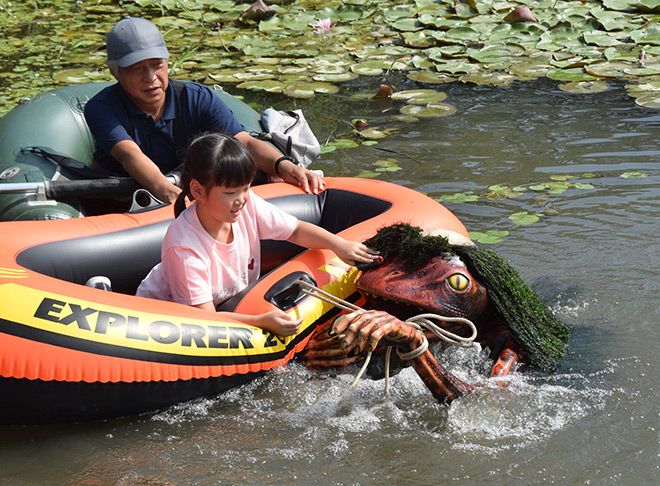FUKUSAKI, Hyogo Prefecture — A spooky effort to transform the hometown of renowned folklorist Kunio Yanagita into a paradise for “ghosts” is doing wonders for local tourism, with more than 700,000 visitors expected in fiscal 2023.
Since the town first erected the “kappa” (water imp) sculptures in the pond 10 years ago, tourist numbers have nearly tripled.
According to estimates by the Fukusaki Town Regional Promotion Division, the number of tourists to the town in 2023 is expected to be 701,298, an increase of approximately 97,000 from the previous year (604,379).
Once you’ve made it…
In particular, Tsujikawayama Park, famous for its statue of the kappa Gajiro that springs from a pond, attracted 167,000 tourists, 28,000 more than the previous year.
More than 80,000 people came to Fukusaki to see the roughly 20 yokai statues that were placed on public benches around the town, 27,000 more than the previous year.
56,000 people also visited the Tsujikawa Tourism Exchange Center, which sells yokai goods and local gourmet food.
In 2013, Fukusaki embarked on a full-scale redevelopment project themed around the monsters depicted in works such as “The Tales of Tono” by Yanagita Yanagita (1875-1962).
Since then, the number of visitors has gradually increased from less than 300,000 to over 400,000 in 2016, the year the Yokai Benches were first installed.
A slowdown in tourism was expected due to the spread of the new coronavirus infection, but interest continues to grow, with over 600,000 tourists visiting Fukusaki in fiscal 2022.
A staff member of the town’s regional development department said, “Gajiro will be featured prominently in the media, especially on television, in 2023, and we will see a sharp increase in the number of families visiting the town on day trips to see the yokai.”
“We are also seeing an increase in foreign tourists coming here after finding out about us through social media,” the official said.
The monsters are still appearing
The town of Fukusaki plans to spend 18 million yen ($114,000) this year to develop a yokai-related facility in an effort to revitalize the local community through yokai.
The city will use subsidies from Hyogo Prefecture and the hometown tax system to install a 22nd yokai bench, a lively trick art attraction, new play equipment, and renovate existing sculptures.
The new bench is based on the Sand Hag motif and costs approximately 2.5 million yen.
This trick art, which cost 1 million yen to install, is located at the Tourist Exchange Center in front of Fukusaki Station on the JR Bantan Line and is intended to entertain visitors with an optical illusion.
The Gajiro statue jumping out of a pond in a park will be renovated at a cost of 2 million yen.
But the highlight of all these features will be a playground equipment that will be installed at Tsujikawayama Park, where visitors can meet Gajiro and other yokai. Details have yet to be released, but the attraction is said to cost 9 million yen and be modeled after parts of a kappa’s body.
In the past, Fukusaki City used 25 million yen in national grants for promoting regional revitalization to install a statue of Gajiro in a cylindrical aquarium in front of Fukusaki Station.
This year, although Gajiro is not the official mascot of the municipality, the town decided to celebrate the 10th anniversary of Gajiro’s debut by investing a large amount of money into yokai-related projects.
At a town council meeting in March, Fukusaki Town Mayor Osaki Yoshiharu expressed his desire to send Gajiro to Tono City in Iwate Prefecture, where Yanagita collected the folklore that became the subject of his book “The Tales of Tono.”
“We will work hard to make Gajiro’s first visit to Tono a reality,” Osaki said.

